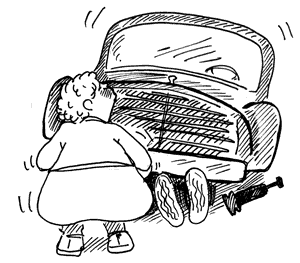STRANGE BUT TRUE- Car jacking: Mom lifts car to save son

DRAWING BY DEBORAH DERR McCLINTOCK
Q. What just might be the two greatest weight-lifting lifts ever, one by a trained male, the other impromptu by a super-motivated Mom? –A. Schwarzenegger
A. The official record was set in 1957 by Paul Anderson, a "back lift" in which he stooped beneath a reinforced wood platform supported by sturdy trestles, says Jearl Walker in The Flying Circus of Physics. Before him was a short stool against which he could steady himself and push downward, above him were auto parts and a safe filled with lead. "With an astonishing effort of both arms and legs, he lifted the platform– the composite weight being 6,270 pounds!" Equally impressive was a reported lift by Mrs. Maxwell Rogers of Tampa, Florida in 1960, whose son was working underneath a car that fell off a bumper jack and onto him. She lifted one end of the car so her son could be rescued by a neighbor. The car weighed 3,600 pounds, of which she lifted at least 25 percent, or nearly 1000 pounds, cracking several of her vertebrae.
Q. What's most amazing about "the Wave," where groups of cheering fans stand in unison and raise their arms, then sit down as the Wave circles round the stadium? The second most amazing thing? –D. Aller
A. First is the lively debate over who started it. Was it at the World Cup Soccer competition in 1986, making it the Mexican wave ("La Ola")? Or at the 1968 Olympic games in Mexico City, or a major league baseball game? Probably Mexico City is correct, says Timothy Gay in Football Physics. Second most amazing is that three Hungarian researchers actually studied Waves at 14 soccer stadiums holding 50,000+ people. They found the Waves generally travel clockwise at 12 meters (20 seats) per second and are 6-12 meters (15 seats) wide. It takes no more than a few dozen participants to get a Wave going. (Science News)
Why a Wave anyway? Boredom with the event is part of it. The clockwise direction may be because fans respond sooner to standers to the right, possibly perceptual or simply tradition, says Gay. One fascinating variable, akin to physical sound waves, is that warmer temperatures speed things up.
"If the fans are really cold and bundled up in big heavy overcoats, they're going to find it harder to jump up when the Wave comes at them." Yet while "absolute zero" (-491 degrees F) will stop a sound wave, it's more like -40 F for the human Wave. "Would you want to do the Wave at 40 below?"
Q. Have you ever experienced a "pogonip," a.k.a. "frost smoke" and "white death"? –R. Peary
A. It's tiny ice crystals suspended near the ground as a mist or fog, says Randy Cerveny in Freaks of the Storm. When warm air from a valley rises up into a cold wind blowing lengthwise, a freezing fog can descend and cover everything with minute frost crystals. A five-day pogonip– the term coined by Native Americans of Nevada– in January 1892 deposited a coating of ice 2 inches thick on trees, buildings, cattle, people!
"I personally saw one in Antarctica in 1987," Cerveny says. "It appeared as a bright line of frosty white on the horizon and trekked across the flat ice sheet for several hours before reaching our camp. We were encased in a white featureless tomb."
Observers in Greenland dubbed it "frost smoke," noting it could cause blisters on the face or hands. Some Native Americans believed the "white death" could rupture the lungs. Indeed in the late 1800s, a group in Colorado reportedly took sick with violent coughs and fever after passing through a pogonip, causing one death.
Send Strange questions to brothers Bill and Rich at [email protected].
#